Contents
- The Learning Gym: Develop Your
Strengths
Page list

By the same authors
The Big Book of Dyslexia Activities for Kids and Teens
100+ Creative, Fun, Multi-sensory and Inclusive Ideas for Successful Learning
Gavin Reid, Nick Guise and Jennie Guise
ISBN 978 1 78592 377 7
eISBN 978 1 78450 725 1
Dyslexia in the Early Years
A Handbook for Practice
Gavin Reid
ISBN 978 1 78592 065 3
eISBN 978 1 78450 327 7
of related interest
Fun Games and Activities for Children with Dyslexia
How to Learn Smarter with a Dyslexic Brain
Alais Winton
Illustrated by Joe Salerno
ISBN 978 1 78592 292 3
eISBN 978 1 78450 596 7
Exploring Science with Dyslexic Children and Teens
Creative, multi-sensory ideas, games and activities to support learning
Diana Hudson
Foreword by John Holman
Illustrated by Jon English
ISBN 978 1 78775 386 0
eISBN 978 1 78775 387 7
Tricky Punctuation in Cartoons
Lidia Stanton
Illustrated by Sophie Kennedy
ISBN 978 1 78775 402 7
eISBN 978 1 78775 403 4
200 Tricky Spellings in Cartoons
Visual Mnemonics for Everyone
Lidia Stanton
Illustrated by Sophie Kennedy
ISBN 978 1 78775 542 0
eISBN 978 1 78775 543 7
The Memory and Processing Guide for Neurodiverse Learners
Strategies for Success
Alison Patrick
Illustrated by Matthew Patrick
ISBN 978 1 78775 072 2
eISBN 978 1 78775 073 9
Dyslexia Is My Superpower (Most of the Time)
Margaret Rooke
ISBN 978 1 78592 299 2
eISBN 978 1 78450 606 3
Practical Activities and Ideas for
Parents of Dyslexic
Kids and Teens
GAVIN REID, MICHELLE MCINTOSH
and JENN CLARK

First published in Great Britain in 2022 by Jessica Kingsley Publishers
An Hachette Company
Copyright Gavin Reid, Michelle McIntosh and Jenn Clark 2022
Front cover image source: Shutterstock. The cover image is for illustrative purposes only, and any person featuring is a model.
All rights reserved. No part of this publication may be reproduced, stored in a retrieval system, or transmitted, in any form or by any means without the prior written permission of the publisher, nor be otherwise circulated in any form of binding or cover other than that in which it is published and without a similar condition being imposed on the subsequent purchaser.
All pages marked with  can be photocopied and downloaded for personal use with this programme, but may not be reproduced for any other purposes without the permission of the publisher.
can be photocopied and downloaded for personal use with this programme, but may not be reproduced for any other purposes without the permission of the publisher.
A CIP catalogue record for this title is available from the British Library and the Library of Congress
ISBN 978 1 78775 761 5
eISBN 978 1 78775 762 2
Jessica Kingsley Publishers policy is to use papers that are natural, renewable and recyclable products and made from wood grown in sustainable forests. The logging and manufacturing processes are expected to conform to the environmental regulations of the country of origin.
Jessica Kingsley Publishers
Carmelite House
50 Victoria Embankment
London EC4Y 0DZ
www.jkp.com
Contents
The Learning Gym: Develop Your
Strengths
Acknowledgements
We would like to acknowledge our students past and present who helped shape our ideas and activities for this book and, of course, their parents and families with whom we have worked closely. They have all brightened our daily work and enriched our practice.
We would also like to acknowledge one of our students, Kiera Loverin, who has a long-standing passion for visual arts and has a dual diagnosis of dyslexia and giftedness. She is Tlingit and Tahltan First Nations and lives in Vancouver, Canada, and contributed a number of the illustrations for this book. She is proud to say this is her first book illustration project.
Preface
Welcome to this activity book for parents of children and young people with dyslexia. We are delighted to be given the opportunity to write this book and we have enjoyed the process very much. We are all very experienced in supporting children and families in a number of capacities and fully appreciate the issues and dilemmas faced by parents and carers of children and young people with dyslexia. These issues have taken on a great intensity due to the COVID-19 pandemic and the increase in home tutoring and remote teaching.
Irrespective of this, it is important that parents are equipped to provide activities and develop and monitor their childs progress. Although this is obviously carried out in conjunction with the school, it is nevertheless an important role for parents.
In our respective roles as parents, teachers and psychologists, we have developed these activities, using our experiences, with the prime purpose of supporting parents and helping them support their children. We have made the activities accessible and interesting; they are also varied and we have incorporated the key areas of need for children and young people with dyslexia: reading, writing, spelling, social and emotional issues, executive functioning and learning skills. We have endeavoured to provide a stimulating and comprehensive range of activities for the learners.
Ideally, we are attempting to promote self-sufficiency in learning but for children with dyslexia this is extremely challenging. We have therefore provided follow-up exercises and teaching tips to help parents take their child through the activities without pain or tears! We appreciate that frustration and sometimes avoidance are features of the child with dyslexia and we hope the activities will stimulate and engage the young person and thereby play a part in promoting self-learning.
It is our sincere hope that this book is a welcome source of support for parents and provides children with stimulating activities that make learning engaging and fun! We have also included a section on social and emotional issues as our experiences tell us that a happy learner is a successful learner! We hope this book brings some happiness to parents and children!
Gavin Reid, Michelle McIntosh, Jenn Clark March 2021
How to Use this Book
We would like to give you some advice on how to use this book although we are sure that it is very straightforward and you will be able to access the ideas and strategies very well.
We have divided the book into chapters, each dealing with an important area to help you access the information you need easily. As well as areas such as reading, spelling and writing, we have also included executive functioning, social and emotional factors and learning skills. It is too easy for these three areas to be overlooked as literacy is usually prioritized, and these terms will be explained in the chapters that follow.
There is no right order to progress through the book. It is very much a dip in book and you can start wherever you want. We have tried to cater for a broad range of ages and provided a clear focus on how you as a parent can use these activities with your child.
The first chapter provides an overview of dyslexia and this will likely answer the questions we find parents often ask, such as what is dyslexia and how can I as a parent help my child?
We have introduced each activity with a comment usually indicating why the activity is important and how the activity can be carried out. There is also an approximate time you should put aside for the activity.

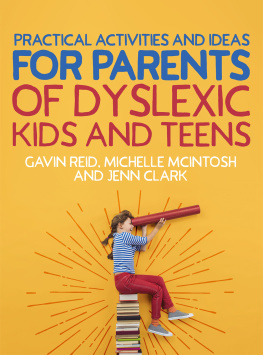



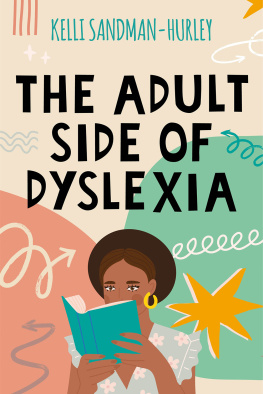
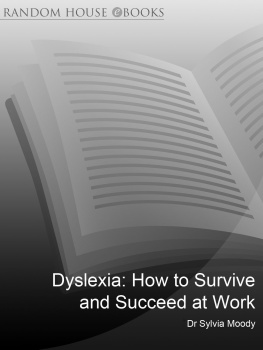

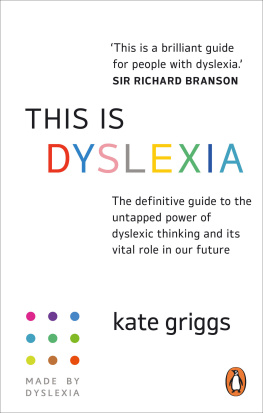

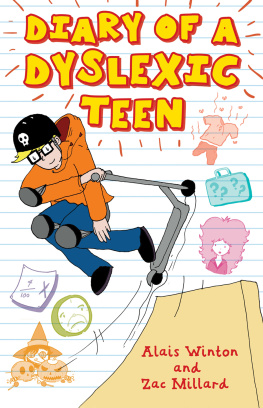
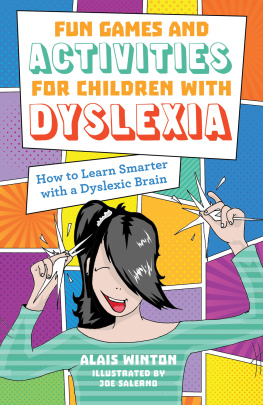
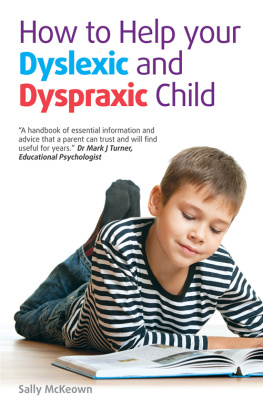
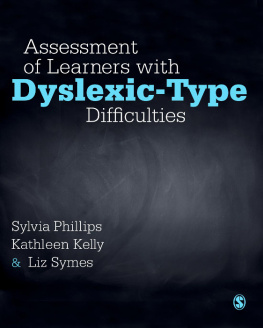


 can be photocopied and downloaded for personal use with this programme, but may not be reproduced for any other purposes without the permission of the publisher.
can be photocopied and downloaded for personal use with this programme, but may not be reproduced for any other purposes without the permission of the publisher.